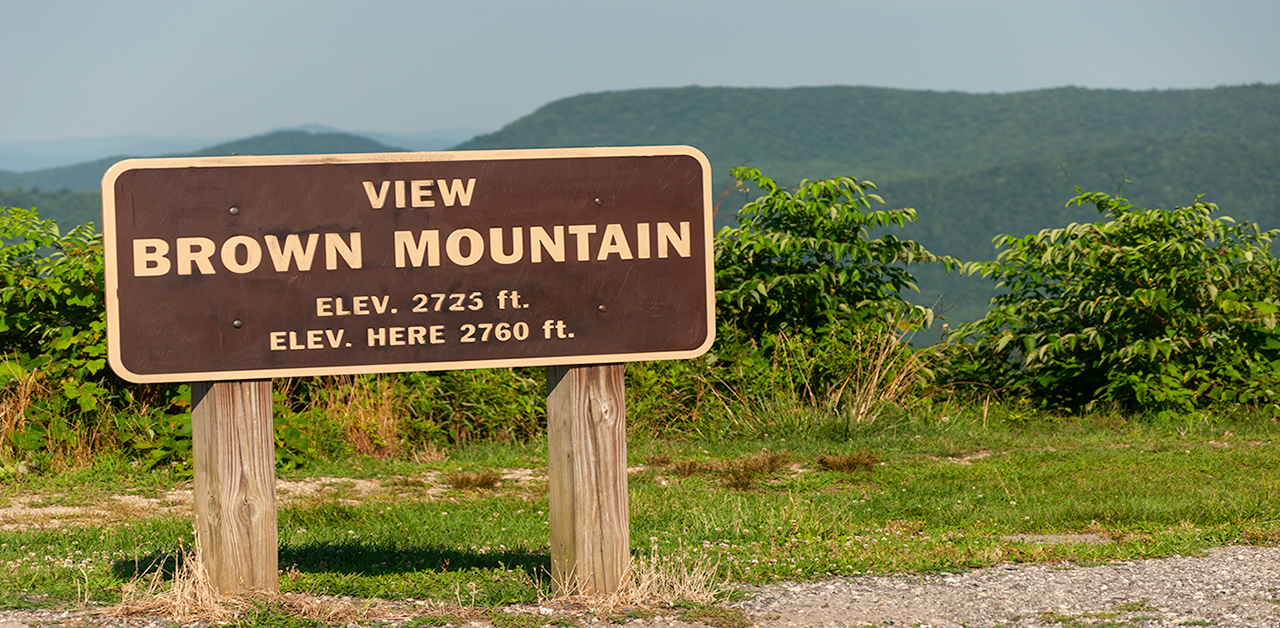The history of the Blue Ridge Mountains is riddled with Appalachian folklore, including the Mysterious Brown Mountain Lights of Morganton NC.
They range from various age-old superstitions to mythical monsters such as Bigfoot, Mothman, and the Snallygaster, a half-bird, half-reptile chimera that reportedly terrorized 18th century German immigrants.
One of the more famous Appalachian folktales involves the mysterious Brown Mountain lights, eerie “ghost lights” that have been seen in the North Carolina mountains for more than 200 years.
On dark nights, these glowing orb-like lights can be seen rising approximately 15 feet off the ground in the Brown Mountain area, which is located approximately 65 miles northeast of Asheville in the Pisgah National Forest.
Numerous reports over the last two centuries suggest that the lights briefly hover in the air, suddenly vanish, and sometimes reappear moments later.
They’ve been seen in various colors, including blue, white, orange, and red. Onlookers have reported seeing the lights floating in midair, both by themselves and in groups of hundreds.
There is, of course, no guarantee that the lights will appear on any given night. However, they are commonly seen around the time the Fall colors in North Carolina reach their peak, especially after it rains.
Here we’ll delve into the history and mystery of the Brown Mountain Lights, including the best viewing areas from which you may have a chance to see them.
READ MORE: The Best Christmas Lights in North Carolina
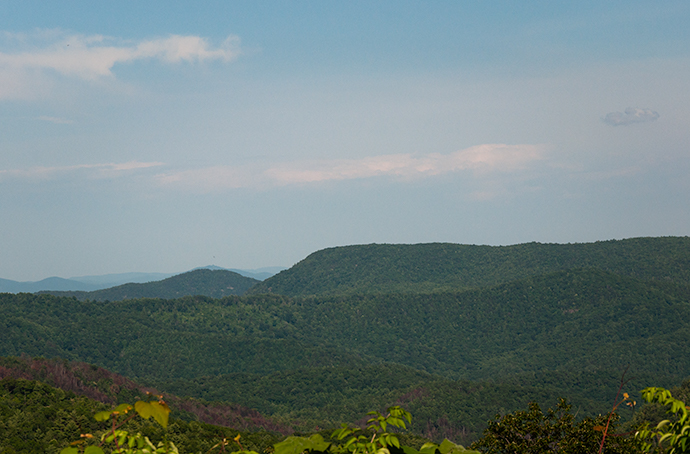
Best Brown Mountain Lights Viewing Areas
Brown Mountain Overlook
Located on NC-181 between mile marker 20 and 21, the Brown Mountain Overlook is the most popular spot for viewing the lights.
This overlook is 12 miles north of the town of Morganton NC, and one mile south of the Barkhouse Picnic Area.
It’s about 30 miles south of Boone on NC-105 S and NC-181. It’s approximately 70 miles east of Downtown Asheville on I-40 E.
Wiseman’s View Overlook
Located in the Linville Gorge Wilderness, Wiseman’s View Overlook provides excellent views of the Table Rock and Hawksbill Mountains. The Brown Mountain lights can occasionally be seen along the summit ridges and in Linville Gorge.
However, the drive there should not be viewed lightly. Located five miles south of Linville Falls on State Road 1238, the drive takes you on a pothole-riddled gravel road for approximately 20 minutes.
Once you arrive at the parking area, there’s a short walk to the overlook.
This overlook is around 30 miles from Boone on NC-105 S, or 60 miles from Asheville on I-40 E and US-221 N.
Lost Cove Cliffs Overlook
The Lost Cove Overlook on the Blue Ridge Parkway also offers views of Brown Mountain. However, It can be difficult to see when there’s Summer and Fall foliage due to the surrounding plant life.
The overlook is located two miles from the NC-181 junction at milepost 310, about six miles north of Linville Falls.
The overlook is around 20 miles from Boone on NC-105 S, or around 60 miles from Asheville on I-40 E and US-221 N.
READ MORE: The 15 Best Hiking Trails in Boone NC
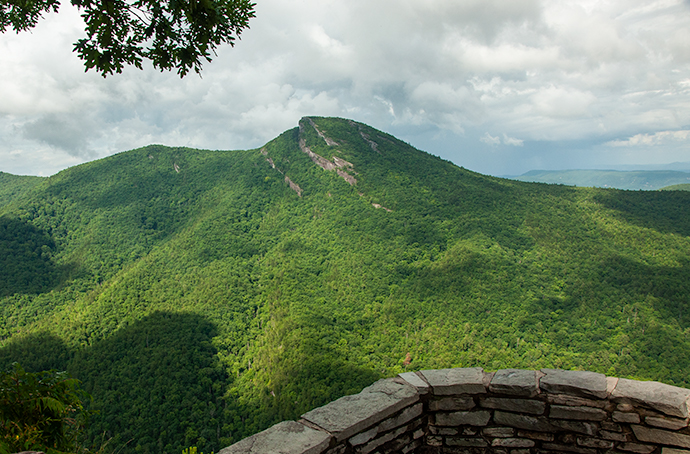
History of the Brown Mountain Lights
There are various claims that Cherokee and Catawba Indians saw the mysterious lights hundreds of years ago, as did early settlers and Civil War soldiers.
The first recorded sighting of the Brown Mountain Lights occurred in 1771, when German engineerJohn William Gerard de Brahm reported seeing the lights in his journal.
He wrote about nitrous vapors that produced globes of light when mixed with the wind, saying that the vapor would catch fire and take on the appearance of lights.
Another early recorded sighting of the lights occurred around 1858, when Fate Wiseman claimed that he saw the strange lights while camping at Wiseman’s View with his father.
He later told his nephew that he’d seen them every night at almost the same time, which led some historians to believe that he’d actually been seeing the lights of a distant railroad train.
This story reportedly passed down through the Wiseman family for years until being published in 1971.
In 1913, men from the Morganton Fishing Club reported seeing mysterious red lights above the Brown Mountain ridge, first at 7:30 PM and then again at 10 PM. The Charlotte Observer recorded this sighting in 1924.
Reported sightings increased throughout the 20th century as the Linville Gorge area experienced electrification. The U.S. Geological Survey even investigated the lights twice.
They found that most locals were unaware of the lights until 1910 or later. This led experts to conclude that the lights originated in the widespread electrification of the Gorge from the 1890s through the early 1900s.
In 1913, the investigation concluded that the Brown Mountain lights were actually distant train and car lights. However, when a flood halted traffic on the mountain for weeks, the lights were still reportedly seen, so this theory lost traction.
READ MORE: The Appalachian Culture & History of the Blue Ridge Mountains

Brown Mountain Lights Legends
There are plenty of theories from local legends for the origin of the lights. One popular story holds that the lights are the souls of 13th century Cherokee Indian women searching for their men, who died in a battle on Brown Mountain.
Another story posits that the lights are the ghosts of a murdered mother, Belinda, and her newborn child. Belinda had been in an arranged marriage with Jim, her abusive, adulterous husband.
After the baby was born, Jim reportedly arranged for the murder of Belinda and their baby. The myth suggests that the Brown Mountain Lights led a search party to the remains of the mother and child in the wilderness.
There are also myths about the ghosts of both Revolutionary War and Civil War soldiers. These stories suggest that the lights are the ghosts of these soldiers, searching for their lost families with torches.
Another story suggests the lights are the ghosts of local gem miners in Brown Mountain, walking through the area with lanterns and torches in an attempt to continue mining.
One theory suggests that the lights are fairies, and many locals believed the lights were aliens from other dimensions. Ralph Leal published a book in 1965 that claimed aliens abducted him from Brown Mountain.
In Lael’s book, The Brown Mountain Lights, he recounts following the alien lights and having a conversation with them. Hesaid the aliens led him to a crystal cave, told him the secret of humanity, and took him to their home planet of Venus.
READ MORE: The Best Places to Celebrate Christmas in North Carolina
Brown Mountain Lights in Pop Culture
These strange lights have gradually gained a prominent presence in pop culture.
They were initially made famous by a 1962 bluegrass song by Lulu Belle and Scotty, “The Legend of the Brown Mountain Lights,” which tells the story of their mysterious origin.
It was written and performed by Scotty Wiseman, who grew up in Western North Carolina hearing fantastical stories about the lights from his great uncle, Fate Wiseman.
His song tell the story the Wiseman family passed down through the generations, which claims that the lights are actually the ghost of a slave carrying a lantern on Brown Mountain in search of his lost master.
The lights have since been featured on television and in movies countless times, including episodes of Ancient Aliens, Mystery Hunters, Weird or What? and, most famously, The X-Files.
The latter cult classic used the lights as the subject of a 1999 episode, “Field Trip,” which depicts a mysterious case of missing hikers in the Brown Mountain area.
When skeletal remains of the hikers are found nearby, Agents Mulder and Scully investigate the case, and one character believes that aliens are responsible for the deaths.
A 2014 film, Alien Abduction, creates a psychological thriller around the eerie lights. Shot in Avery, Watauga, and Burke Counties, the movie depicts a family camping trip in the Brown Mountain area gone awry.
The family mysteriously goes missing and is not seen again for a year. When at last they’re found, they’re disheveled, horror-stricken, and forever changed by the ghost lights.
READ MORE: 40 Fascinating Facts About the Blue Ridge Parkway
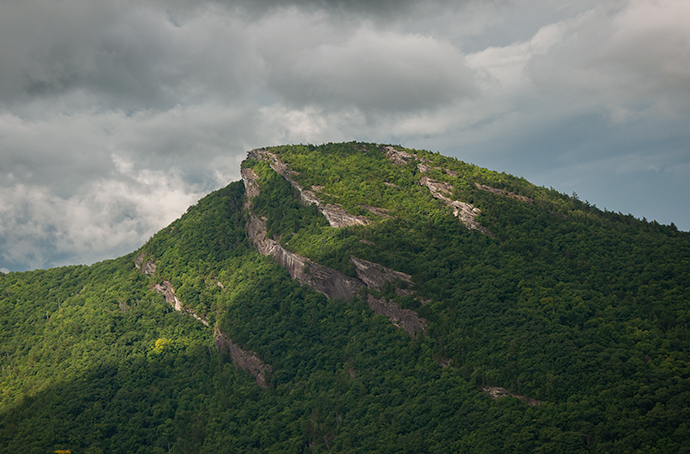
Things To Do in the Brown Mountain Area
The location of Brown Mountain makes it the perfect spot for a weekend or day trip.
There are many activities nearby, including gorgeous waterfalls, an array of Pisgah National Forest hiking trails, and lots of options for Pisgah National Forest Cabins & Camping.
Hiking Trails Near Brown Mountain
The Hawksbill Mountain trail is a 1.5-mile round-trip hike to the summit of Hawksbill Mountain. This strenuous trail is short, but steep, with the summit reaching 4,049 feet in elevation and overlooking Linville Gorge.
Hikers can find views of Table Rock Mountain to the left of the summit and picnic areas to the right. The trailhead is located around 35 miles from Morganton in the Linville Gorge Wilderness.
The Table Rock Mountain trail is a 2.2-mile round-trip hike to the summit of Table Rock Mountain. This trail is also steep and strenuous, and is known for being a good rock-climbing spot.
The summit reaches 4,101 feet in elevation, overlooking Linville Gorge, Shortoff Mountain, and Hawksbill Mountain. The trailhead is about 35 miles from Morganton in the Linville Gorge Wilderness Area.
The Chimneys Hike is a 1.5-mile round-trip hike along the Chimney rock formations in Linville Gorge. This hike provides an excellent view of Table Rock Mountain, but extreme caution is crucial when hiking the rocky cliffs.
Hikers may follow the trail to reach the top of Table Rock, or they can hike beyond the Chimneys to reach Shortoff Mountain.
There are several side trails off of the main trail, many of which are favored by rock climbers. The trailhead is around 35 miles from Morganton in the Linville Gorge Wilderness Area.
The Shortoff Mountain trail is a 4.5-mile round-trip hike to the 2,883 foot summit of Shortoff Mountain in Linville Gorge. The first half of the hike is quite steep, but it levels out toward the end.
The hike provides picturesque views of the Gorge, Table Rock Mountain, Linville River, and Lake James, as well as a natural pond at the summit.
The trailhead is around 35 miles from Morganton in the Linville Gorge Wilderness Area.
READ MORE: The 20 Best Blue Ridge Parkway Hikes for NC Day Trips
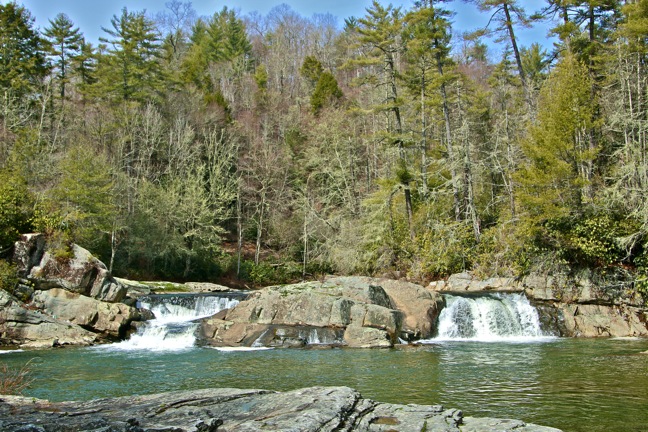
Waterfalls Near Brown Mountain
Linville Falls is a 90-foot waterfall in Linville Gorge, located on the Blue Ridge Parkway near Milepost 316.4. There are various overlook trails from which to view the falls, all of which begin at the Linville Falls Visitors Center.
- Erwins View Trail is a 1.6-mile round-trip hike to a wonderful view of the falls. Along the way, hikers will also see the Upper Falls and Chimney View. This trail is considered relatively easy by most hikers, and the highest elevation is 3,360 feet.
- Plunge Basin View Trail is a 1.8-mile round-trip hike to the base of the falls. The hike is short, but steep, and hikers should be aware of its moderately rough conditions. The highest elevation is 3,240 feet.
- The Linville Falls Trail is a scenic 2.2-mile round-trip hike through the trees to several overlooks of the falls. This hike is considered relatively easy by most hikers, and is widely considered one of the best Blue Ridge Parkway hiking trails.
Linville Falls is located in the Linville Gorge Wilderness, around 35 miles from Morganton and just five miles north of the Wiseman’s View overlook.
READ MORE: The 15 Best Blue Ridge Parkway Waterfalls in North Carolina
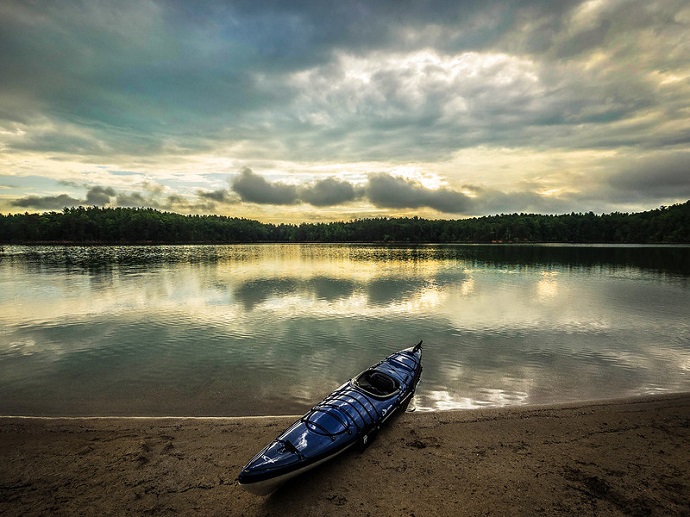
Camping Near Brown Mountain
Lake James State Park is one of the most popular state parks in the North Carolina mountains.
It’s home to three campgrounds, a 6,812-acre lake, a 700-foot-long beach, and 25 miles of hiking trails.
These trails vary from short, easy, child-friendly hikes to longer, more challenging and adventurous treks. The park is one of the area’s most popular places for swimming, boating, and fishing.
Lake James State Park is located around 20 miles from Morganton, and offers canoe, kayak, and paddle board rentals from May through September.
READ MORE: The 10 Best Lakes in the North Carolina Mountains to Visit

Other Activities Near Brown Mountain
• The Linville Caverns are active mineral deposits inside Humpback Mountain. The natural limestone caverns are filled with stalactite and stalagmite formations, as well as an underground stream. The caverns are open for public touring and are located around 35 miles from Morganton.
• Apple Hill Orchard & Cider Mill is located at 2075 Pleasant Hill Ave. in Morganton. They offer pick-your-own apple orchards, wagon tours of the orchard, and homemade goods available for purchase from the market.
• Thermal Valley Hang Gliding is located at 4098 Old Amsterdam Rd in Lenoir NC. Visitors will be given training on the ground before putting on their harness. Then they’ll glide through the air with an instructor, seeing the glorious mountains from a bird’s-eye view. Flights last 8-12 minutes and reach an altitude of 1500 feet, with an average cost of $159 per person.
• The Catawba Valley Wine Trail is located at 2240 S Creek Rd in Nebo NC, around 30 miles from Morganton. Located along the Catawba River, the wine trail features five wineries, each of which offers wine tastings and tours.
• Perry’s Berry’s Vineyards & Winery is located at 1136 Browning View Rd in Morganton. Guests can pick their own blueberries and taste signature blueberry wine. Additionally, the winery provides charcuterie boards for picnicking and sells a variety of homemade foods. –by Maggie Watts; all photos by Dawson Tozier unless otherwise noted

